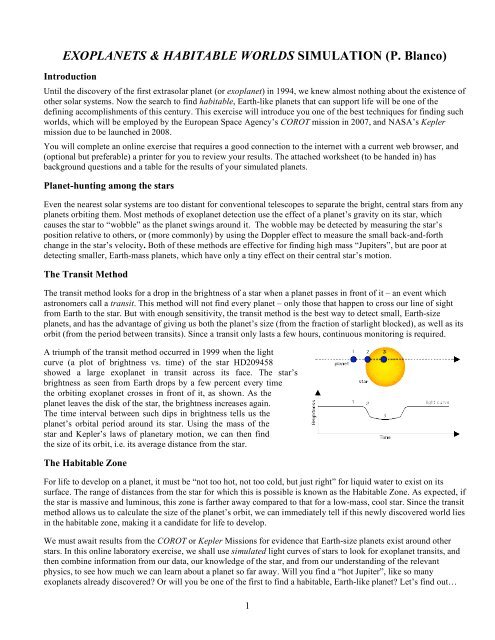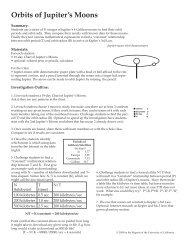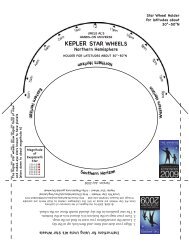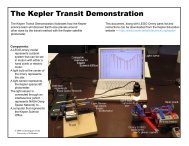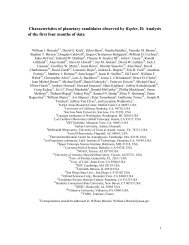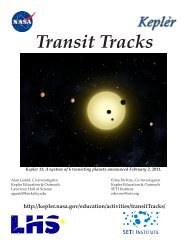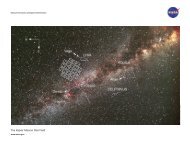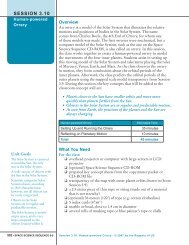EXOPLANETS & HABITABLE WORLDS SIMULATION (P ... - Kepler
EXOPLANETS & HABITABLE WORLDS SIMULATION (P ... - Kepler
EXOPLANETS & HABITABLE WORLDS SIMULATION (P ... - Kepler
You also want an ePaper? Increase the reach of your titles
YUMPU automatically turns print PDFs into web optimized ePapers that Google loves.
<strong>EXOPLANETS</strong> & <strong>HABITABLE</strong> <strong>WORLDS</strong> <strong>SIMULATION</strong> (P. Blanco)<br />
Introduction<br />
Until the discovery of the first extrasolar planet (or exoplanet) in 1994, we knew almost nothing about the existence of<br />
other solar systems. Now the search to find habitable, Earth-like planets that can support life will be one of the<br />
defining accomplishments of this century. This exercise will introduce you one of the best techniques for finding such<br />
worlds, which will be employed by the European Space Agency’s COROT mission in 2007, and NASA’s <strong>Kepler</strong><br />
mission due to be launched in 2008.<br />
You will complete an online exercise that requires a good connection to the internet with a current web browser, and<br />
(optional but preferable) a printer for you to review your results. The attached worksheet (to be handed in) has<br />
background questions and a table for the results of your simulated planets.<br />
Planet-hunting among the stars<br />
Even the nearest solar systems are too distant for conventional telescopes to separate the bright, central stars from any<br />
planets orbiting them. Most methods of exoplanet detection use the effect of a planet’s gravity on its star, which<br />
causes the star to “wobble” as the planet swings around it. The wobble may be detected by measuring the star’s<br />
position relative to others, or (more commonly) by using the Doppler effect to measure the small back-and-forth<br />
change in the star’s velocity. Both of these methods are effective for finding high mass “Jupiters”, but are poor at<br />
detecting smaller, Earth-mass planets, which have only a tiny effect on their central star’s motion.<br />
The Transit Method<br />
The transit method looks for a drop in the brightness of a star when a planet passes in front of it – an event which<br />
astronomers call a transit. This method will not find every planet – only those that happen to cross our line of sight<br />
from Earth to the star. But with enough sensitivity, the transit method is the best way to detect small, Earth-size<br />
planets, and has the advantage of giving us both the planet’s size (from the fraction of starlight blocked), as well as its<br />
orbit (from the period between transits). Since a transit only lasts a few hours, continuous monitoring is required.<br />
A triumph of the transit method occurred in 1999 when the light<br />
curve (a plot of brightness vs. time) of the star HD209458<br />
showed a large exoplanet in transit across its face. The star’s<br />
brightness as seen from Earth drops by a few percent every time<br />
the orbiting exoplanet crosses in front of it, as shown. As the<br />
planet leaves the disk of the star, the brightness increases again.<br />
The time interval between such dips in brightness tells us the<br />
planet’s orbital period around its star. Using the mass of the<br />
star and <strong>Kepler</strong>’s laws of planetary motion, we can then find<br />
the size of its orbit, i.e. its average distance from the star.<br />
The Habitable Zone<br />
For life to develop on a planet, it must be “not too hot, not too cold, but just right” for liquid water to exist on its<br />
surface. The range of distances from the star for which this is possible is known as the Habitable Zone. As expected, if<br />
the star is massive and luminous, this zone is farther away compared to that for a low-mass, cool star. Since the transit<br />
method allows us to calculate the size of the planet’s orbit, we can immediately tell if this newly discovered world lies<br />
in the habitable zone, making it a candidate for life to develop.<br />
We must await results from the COROT or <strong>Kepler</strong> Missions for evidence that Earth-size planets exist around other<br />
stars. In this online laboratory exercise, we shall use simulated light curves of stars to look for exoplanet transits, and<br />
then combine information from our data, our knowledge of the star, and from our understanding of the relevant<br />
physics, to see how much we can learn about a planet so far away. Will you find a “hot Jupiter”, like so many<br />
exoplanets already discovered? Or will you be one of the first to find a habitable, Earth-like planet? Let’s find out…<br />
1
Transit Method Simulation: Procedure<br />
From a current web browser, go to one of the websites given on the next page to start running the simulation, which<br />
guides you through 8 pages of information and calculations.<br />
Page 1: Read the Introduction on this web page – you will have to answer questions later. Then select the<br />
“Simulation” link, and you will be directed to page 1 of the exercise, which shows a patch of sky with stars, numbered<br />
1 through 8. Pick a star to analyze. You will see a plot of the star’s “light curve” (brightness as a function of time). If<br />
the star has a planet whose orbit causes transits along our line-of-sight, you will see periodic “dips” in this plot. As<br />
carefully as you can (here is where a printer will help), estimate the Period P of the planet’s orbit.<br />
Page 2: A star’s “spectral type” (which is related to its mass, temperature, and power output) is given by a letternumber<br />
code. For instance, our star is a “G5”, where as a lower mass star could be a “K2”. (The letter sequence from<br />
high- to low- mass is OBAFGKMRN, remembered as “Oh Be A Fine Guy/Girl Kiss Me Right Now!”). From the<br />
table given, look up and enter the star’s mass. orbit. Select Calculate and the program use <strong>Kepler</strong>’s 3 rd law (P 2 =a 3 /M)<br />
to calculate the size of the planet’s orbit. You’re now on your way to finding out more about the [simulated] exoplanet<br />
you have discovered!<br />
Page 3: Plotting your star’s mass vs. your planet’s orbital distance, you can determine whether your new planet falls<br />
within the central star’s Habitable Zone. This is the zone generally considered to be “not too hot, not too cold, but just<br />
right” for liquid water to exist in the presence of at atmosphere – conditions which are thought to be essential for life<br />
to develop. You may find it easier to accomplish this task by printing a paper copy of the plot provided.<br />
Page 4 uses the central star’s radius and temperature are to estimate your exoplanet’s temperature at its orbital<br />
distance (assuming a circular orbit). Here the temperatures are expressed in Kelvin above absolute zero. So, for<br />
example, 0°C = 32°F = 273 K. Planets with temperatures around 300 K could be considered “habitable”. Obviously, a<br />
planet’s temperature will increase with the star’s temperature and size, but decrease with orbital distance. Luckily for<br />
you, the computer does most of the work once you have provided the information. Look up the star’s radius and<br />
temperature for its spectral type from the tables provided, enter the information and select Calculate.<br />
Page 5 is an “automatic” calculation of your planet’s physical size, based on the drop in light output as it transits the<br />
face of the star. Simply select Calculate, but be sure to read the information presented on this page.<br />
Page 6 uses two separate “models” of a planet’s density based on the planets in our solar system, to estimate the<br />
possible mass of the new exoplanet. (Unlike the “stellar wobble” methods of detection, the transit method does not<br />
give us a planet’s mass directly). One model uses your exoplanet’s radius, the other uses its distance from the star –<br />
both of which have already been calculated. From each of the curves presented for each model, estimate your planet’s<br />
density, and select Calculate. Do not be concerned if the two mass estimates are vastly different! With more<br />
exoplanets being found by various methods, we hope that soon we can construct better models of solar system<br />
contents, instead of just relying on our own (possibly atypical) solar system.<br />
Page 7 concludes the simulation with an “automatic” calculation of the probability of detecting such a planet. Since<br />
planetary systems will only orbit in the plane containing our line-of-sight by chance, the <strong>Kepler</strong> mission will only<br />
detect a fraction of all exoplanets. But by observing many stars, we should expect success in a significant number of<br />
cases.<br />
Page 8 presents a summary of all the parameters you have calculated, which you can use to complete the summary<br />
table on the worksheet.<br />
NOW REPEAT THE <strong>SIMULATION</strong> WITH A DIFFERENT STAR. Note the some of the stars do not have<br />
detectable planets in this exercise, so if this is the case, make a note of the star’s ID# and select another. Happy planet<br />
hunting!<br />
2
The simulation website is at:<br />
http://www.bridgewater.edu/~rbowman/ISAW/Transit-1.html<br />
If for some reason this website is not accessible, an alternate site to run the simulation is:<br />
http://www.astro.lsa.umich.edu/Academics/Undergrad/Labs/exoplanets/Transit-1.html<br />
SUMMARY TABLE for the two simulated exoplanets<br />
EXOPLANET SYSTEM INFORMATION 1st simulation 2 nd simulation<br />
Star ID (#1-8), and spectral type (e.g. A0, G5, K2)<br />
Star’s mass M Star (solar masses)<br />
Star’s radius R Star (solar radii)<br />
Star’s surface temperature T Star (Kelvin)<br />
Notes:<br />
Planet’s measured orbital Period P (yr)<br />
Planet’s orbital size (semi-major axis) a (A.U.)<br />
Planet orbits in the Habitable Zone? (Yes or No)<br />
Planet’s estimated surface temperature T P (K)<br />
Planet’s radius R P (Earth radii)<br />
Planet’s mass range (in Earth masses, min. to max.)<br />
e.g. “1.3 – 2.8”<br />
Probability of discovery (%)<br />
• Some stars in this exercise do not have exoplanets that produce a good light curve with a measurable period<br />
between transits. If you select one of these, make a note of its ID number below the table, then pick another star.<br />
• Boxes containing the words “automatic” are not for data entry. After you have filled the other boxes with the<br />
necessary data, select Calculate and the computer will update these boxes (and its ongoing summary of results, see<br />
below).<br />
• In order to answer the questions properly, you will need to READ the background information on each page of<br />
the simulation. Much of this information is given below the Next button, so scroll down to read it (or print each page).<br />
• The simulation keeps track of any calculations made, so if you need a piece of information about the star, or the<br />
exoplanet, look for it in the ongoing summary at the top of the web page. You can also record your results in the<br />
Summary Table above as you progress through the simulation, or simply copy the numbers from the final page of the<br />
exercise.<br />
3
Exoplanets Simulation Worksheet. TO BE HANDED IN! NAME: _________________<br />
1. Briefly, describe in words the transit method of detecting an extrasolar planet.<br />
2. From the period P (in Earth years) of a planet’s orbit around a star of mass M Star solar masses, we can use <strong>Kepler</strong>’s<br />
3 rd law P 2 =a 3 /M Star to find the size of the planet’s orbit a in Astronomical Units (A.U.). If we see a planet orbiting a<br />
star of mass M Star = 2.5 solar masses with an orbital period P=3.0 years, what is the size of its orbit?<br />
Size of orbit a = ___________ A. U.<br />
3. What is meant by the Habitable Zone around a star? From the graph shown on page 3 of the simulation: would you<br />
expect the habitable zone for a low-mass star to be closer in, farther out, or the same distance from the star, compared<br />
to the habitable zone around our Sun? Give a reason for your answer.<br />
4. The transit method gives us a planet’s size radius R, but not its mass. For that, we also need the planet’s average<br />
density. Suppose a planet has a radius R = 5.6 ×10 6 m. If its average density is 4200 kg/m 3 , calculate the planet’s mass:<br />
(a) in kg, and (b) in Earth masses. (Volume of sphere = 4 / 3 πR 3 , Earth’s mass = 6.0×10 24 kg)<br />
a. Planet mass in kg: ____________ kg. b. Planet mass in Earth masses: __________ M Earth<br />
Show your calculation work here:<br />
4


